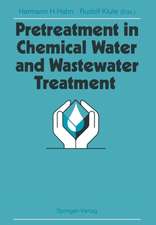Chemical Water and Wastewater Treatment II: Proceedings of the 5th Gothenburg Symposium 1992, September 28–30, 1992, Nice, France
Editat de Rudolf Klute, Hermann H. Hahnen Limba Engleză Paperback – 26 dec 2011
Preț: 654.95 lei
Preț vechi: 770.53 lei
-15% Nou
Puncte Express: 982
Preț estimativ în valută:
125.32€ • 130.86$ • 103.49£
125.32€ • 130.86$ • 103.49£
Carte tipărită la comandă
Livrare economică 15-29 aprilie
Preluare comenzi: 021 569.72.76
Specificații
ISBN-13: 9783642778292
ISBN-10: 3642778291
Pagini: 520
Ilustrații: XII, 505 p.
Dimensiuni: 170 x 242 x 27 mm
Greutate: 0.82 kg
Ediția:Softcover reprint of the original 1st ed. 1992
Editura: Springer Berlin, Heidelberg
Colecția Springer
Locul publicării:Berlin, Heidelberg, Germany
ISBN-10: 3642778291
Pagini: 520
Ilustrații: XII, 505 p.
Dimensiuni: 170 x 242 x 27 mm
Greutate: 0.82 kg
Ediția:Softcover reprint of the original 1st ed. 1992
Editura: Springer Berlin, Heidelberg
Colecția Springer
Locul publicării:Berlin, Heidelberg, Germany
Public țintă
Professional/practitionerDescriere
With joy and pride parents observe the coming of age of their children, confer. , ence conveners the acceptance of their programmes, and editors the demand for their volumes. The scientific advisory board of the Gothenburg . . Symposia, the Springer publishing house of the proceedings and the editors are more than pleased with the fact that the demand for these books far exceeds the supply. The themes vocalized by the Gothenburg Symposia reHect research and development needs for the environment more than envisioned at the concep tion of the conferences. An environment-oriented analysis of the situation, not confined to the European community, furnishes the following results: (1) Due to the very high population density in many areas environmental quality is endangered; this has become apparent at the very moment in particular in the aqueous habitat and is corroborated by corresponding regulation proposals from the European Council. (2) Pollution control concepts and measures are developed to a varying degree in many countries of the world, reHecting in most instances the need for environmental protection and the closely related devel opment of (judicial and technical) measures. In most instances these controlling and protective measures need to be intensified. (3) Thus, nearly all countries face the problem of developing and/or improving pollution control strategies, i. e. building new treatment plants, upgrading overloaded or outdated instal lations and designing new operating and controlling strategies for improved plant performance.
Cuprins
Floc Formation.- Particle and Phosphate Removal Mechanisms with Prepolymerized Coagulants.- Model System Studies of Formation and Properties of Flocs Obtained with Cationic Polyelectrolytes.- Amphophilic Cationic Polymers as Both Flocculants and Depollutants.- Coagulation and Flocculation in Alkaline Media — The Role of Ca2+ and Mg2+ Ions.- The Effects of Temperature, pH and Rapid Mixing Gradient on the Formation of Particles in Treatment of Humic Water.- Floc Separation.- Effectivity of Liquid-Solid Separation as a Function of Apparatus Characteristics and Wastewater Quality.- An Analysis of Floc Separation Characteristics in Chemical Wastewater Treatment.- Characterization of Sludges from Wastewater Coagulation with Polymeric Aluminium Salts.- The DENSADEG — A New High Performance Settling Tank.- Chemicals — Dosing Control.- Chemical Dosing Control — Physical and Chemical Boundary Conditions.- Fundamental Considerations in Use of the Streaming Current Detector for Chemical Dose Control.- Particle Separation in Wastewater Treatment.- Comparison of Various Commercially Available Polyaluminium Chlorides (PAC).- Polyaluminium Silicate Sulphate — A New Coagulant for Potable and Wastewater Treatment.- Drinking Water Treatment.- Dissolved-Air Flotation: Theory and Practice.- Experimental Studies on the Kinetics of Flotation.- Algae, Coagulation, and Ozonation.- Improvements in Membrane Microfiltration Using Coagulation Pretreatment.- Wastewater Treatment.- Characterization of Wastewater: The Effect of Chemical Precipitation on the Wastewater Composition and its Consequences for Biological Denitrification.- Pre-precipitation Followed by Biological Denitrification Supported by Addition of Biological or Thermal/Chemical Hydrolysis Products.- Use of Internal Carbon from Sludge Hydrolysis in Biological Wastewater Treatment.- Evaluation of Pre-precipitation in a Wastewater Treatment System for Extended Nutrient Removal.- High Rate Biofilters — Simultaneous Phosphorus Precipitation and Nitrogen Removal.- Denitrification in Submerged Filters of Nitrified Wastewater and Chemical Pre-precipitated Wastewater.- Observed Synergistic Effects of Aluminium and Iron Salts in Nutrients Removal.- Retrofitting Conventional Primary Treatment Plants for Chemically Enhanced Primary Treatment in the USA.- Experiences with Chemical Treatment in Madrid.- Trade-Offs Between Physico-Chemical Lamella Separators and Aerated Biofiltration.- Recent Developments in Wastewater Treatment.- Recent Developments in Industrial Wastewater Treatment: The Role of Physico-Chemical Processes in Metal Control.- Nitrogen Elimination from Digester Supernatant with Magnesium-Ammonium-Phosphate Precipitation.- Zeolite Filters in Wastewater Treatment Plants.- Rapid Sewage Clarification with Magnetite Particles.- Magnetic Floc Separation in Chemical Phosphate Removal.


























